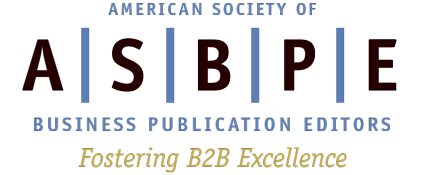If the digital disruption in media has made one thing clear, it’s that long-standing rules and roles are changing fast. No longer does a staff member simply report, or edit, or design, or manage the website. It’s all hands on deck, as ever-shrinking mastheads take on more work across a growing number of platforms. In this series, we’re focusing on the young decision-makers who are having an impact at B2B publishers nationwide. Last month, we featured Sam Oches, editor-in-chief of QSR magazine in Chapel Hill, N.C. This month, the spotlight is on Adrienne Wagner, 28, managing editor at Advanstar Communications.
Wagner joined Advanstar in April 2012 as a managing editor for the company’s Veterinary group following work in marketing. A native of Traverse City, Mich., she earned bachelor’s degrees in magazine editing and Spanish from the University of Missouri School of Journalism in 2008. She was also one of ASBPE’s 2014 Young Leaders Scholars.

The media landscape has changed considerably since 2008, when you got your BSJ, and continues to evolve. How has that impacted your media career goals and skill building?
AW: Although this was definitely not my feeling in 2008 or 2009, I’m lucky to have launched my career when no one was hiring editors. I’ve gotten to test out the waters of marketing, multimedia content creation, and digital publishing—all of which make me a better editor. To get (and keep) a job I wanted, the scope of my skills had to widen. But I also had to play the long game, biding my time by progressing in nontraditional ways until the right opportunity presented itself. So I used a marketing job to get into project management, which turned a managing editor role into a natural progression. As far as career goals, those have always remained the same: Help people, take pride in my work, and challenge myself. The unintentional bonus is that the less specific your goals are, the more successful you are at reaching them.
How did you come to work for Advanstar, and what is your current job?
I was in a job that was unfulfilling and I had been searching for a good while, so my expectations were low. And suddenly I had an interesting, challenging job serving a market that is valuable to the public and meaningful to me. My job is different every day, but basically I support our editorial staff by managing four monthly publications, a portal website, eight e-newsletters, a monthly digital iPad publication, special supplements, multimedia content, and social media platforms. I maintain deadlines across these content channels, working with four editors-in-chief and managing a team of associate editors out of our offices in a suburb of Kansas City. I’m surrounded by highly intelligent, high-performing content producers in an environment that fosters creative thinking. Plus, we laugh a lot, so it’s fun to come to work every day.
What has been the biggest challenge in learning the ropes of the veterinary industry, and what steps have you taken?
I think a common (and sometimes mistaken) impression of B2B journalism is that you have to be an expert in whatever industry you’re serving. When I voiced concerns about a learning curve, my boss said, “We’re all just journalists who learned a market.” So I approached the industry with that mindset. At Advanstar we’re fortunate in that a big part of our business is conferences, which gives us the opportunity to get in front of the leaders and experts. However, I haven’t had challenges with this particular industry so much as I face the same challenges any journalist faces—essentially, the market’s time and resources. And like any journalist, I rely on experts to guide me. I realize it might not be the same for every B2B environment, but my primary focus is what I can do to help my audience (veterinarians) inform their audience (pet owners).
What parts of your job or projects get you the most excited?
The most fulfilling part for me is coming up with new content delivery systems to tell a story. I have crazy ideas like “Let’s do an animated short film!” and no one balks; instead we figure out a way to realize the idea. I’m free to roam the landscape of digital media, borrowing ideas from consumer pubs, and no one says “No.” That’s pretty exciting.
What advice would you give to today’s j-school students who want to work in media about the kinds of opportunities that are available and the skills required?
Maybe it was just the atmosphere at my j-school, but it never really occurred to me to work in B2B publishing. It has treated me well and I would encourage today’s students to give it a go, especially if they can’t afford an unpaid postgrad internship in NYC. I hope today’s j-school students are well aware that they can’t expect to get a job based solely on their writing or editing skills. I want to hire young people who can do way more than I can. One of the best things young editors can do is to become really comfortable generating and voicing ideas. It’s impossible to succeed in this industry without great ideas.
We’re looking for more young leaders to share their stories. Know of one? Tell us through our contact form.
This interview has been edited and condensed.
